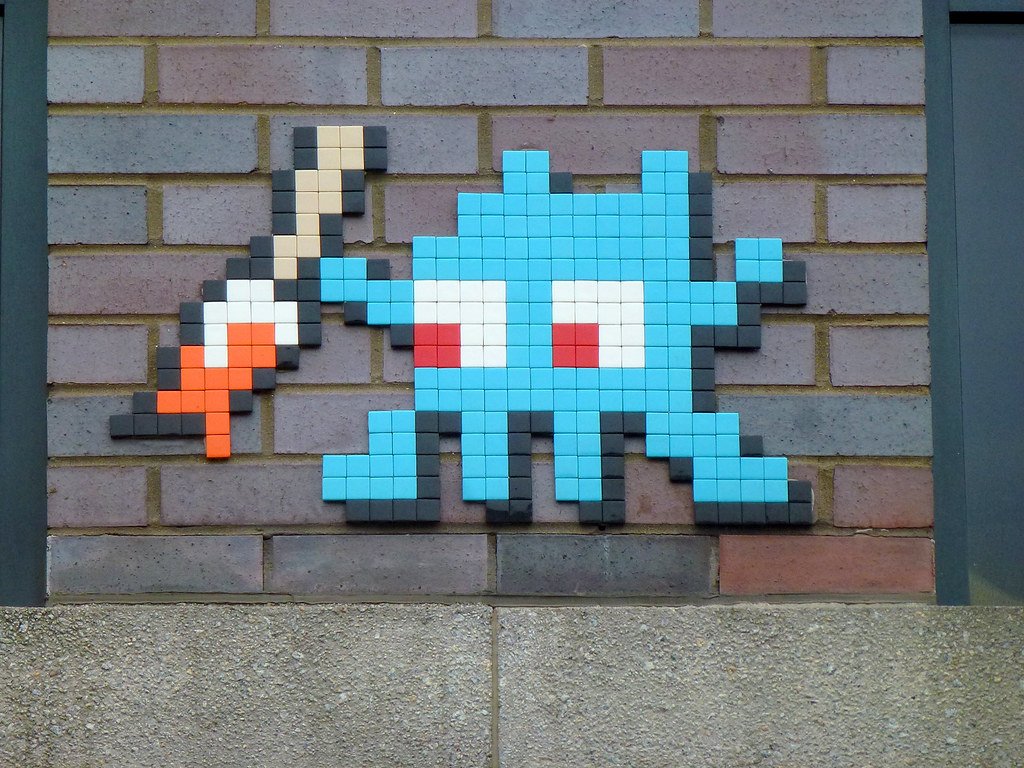The Motive Behind Invader
Read more
Introduction
Invader, the renowned French street artist, is famous for his unique mosaic tile works inspired by the 1978 arcade game Space Invaders. Since the late 1990s when he originated with the idea, Invader has been “invading” cities by installing his unique art on walls, buildings, and other public surfaces. Blending nostalgia for pixelated video games with contemporary street art, his works are often installed mosaics as a part of an ongoing project called Global Space Invasion. Through his distinctive mosaics, he creates a global art project that transcends traditional boundaries and invites everyone to be a part of the invasion.
first mosaic ever created by Invader located in Paris
PA_001 (1996)
Public art
Invader thinks that art should be for everyone, instead of being framed and placed in an air-conditioned room.
It is first of all about liberating Art from its usual alienators that museums or institutions can be.
-Invader
This can be proved by the fact that he placed his art everywhere in the world. He never wanted to make a profit from his art, rather he actively participated in the movement of street art culture.
Through interactive projects like FlashInvaders and Invader Kits, Invader encourages community participation in his creation. The placement and design of his mosaics encourage viewers to explore their environment, turning a simple walk through the city into a treasure hunt for hidden art. Fans and aspiring artists can create their mosaics, contributing to the global invasion and fostering a sense of collective creativity. Having a piece of street art belong to yourself feels too good to be true, but it’s legit and official.
Imagination
Invader had this idea of merging the digital world with the real world. It’s how the invasion idea started.
It is also about freeing the Space Invaders from their video games and TV screens and bringing them into our physical world.
It started by giving a physical pixelization through ceramic tiles. Every squared-shaped tile depicts the 8-bit style of classic pixel games. The difference between modern and classic evokes nostalgia for the early days of video games. Using pixelated designs, he connects with a generation that grew up with these games, blending the past with contemporary art.
LDN_55
PA_909
Anonymity and Mystery
The artist's anonymity is central to his practice, which adds an air of mystery and intrigue to his urban interventions. Invader maintains secrecy around his identity, preferring to let the work speak for itself rather than cultivating a public persona. His mosaics invade urban environments, often appearing in unexpected places, creating a sense of surprise and discovery for passersby with his unknown identity.
By maintaining anonymity, Invader adds an element of mystery and intrigue to his work, which helps bring the focus to the work instead of the artist's fame. This anonymity also protects him from legal issues related to unauthorized public installations, allowing him to continue his work without personal repercussions.
MARS_97
Urban Transformation
The initial idea of deploying invading creatures on the walls of Paris soon developed into a worldwide art movement. A significant motive is to transform urban spaces into galleries. Invader is trying to make people stop staring down at their phones and look up and gaze upon the beautiful environment. Invader's mosaics are strategically placed in cities worldwide, turning dull public spaces into canvases for art, thus democratizing access to art by taking it out of traditional galleries and into the streets
I first wanted to create a series of "canvases" but I soon realized that tiles were the perfect material to display these pieces directly on the walls.
LDN_142
What do you think the real motive of Invader is? Leave it in the comments below.
All Rights Reserved
~
We do not own any copyrights to the photos used
~
All Rights Reserved ~ We do not own any copyrights to the photos used ~




























